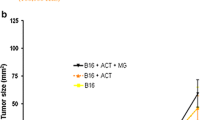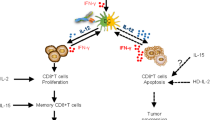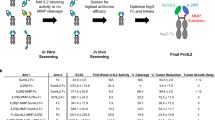Abstract
Background: Interleukin-2 (IL-2)-based immunotherapy has been shown to effect clinical responses in 15–35% of patients with metastatic renal cell carcinoma or melanoma. Despite its clinical efficacy, many clinicians refrain from using IL-2 because of the associated toxicity. This toxicity is believed to be mediated by such secondary cytokines as IL-1, tumor necrosis factor (TNF), and interferon (IFN)-γ, which are produced by the patient's IL-2-stimulated peripheral blood mononuclear cells (PBMCs).
Methods: Human PBMCs were stimulated with 1 nM wild-type recombinant IL-2 (rIL-2) or IL-2 analogs (R38A or F42K) that preferentially bind to the intermediate affinity IL-2 receptor (IL-2R). PBMCs were activated for lymphokine-activated killer (LAK) activity in 4-h51Cr-release assays, using Daudi target cells. Cytokine content in the culture supernatants was determined by enzyme-linked immunosorbent assay.
Results: Both R38A and F42K were capable of generating substantial LAK activity. Maximal specific lysis was 54% for PBMCs activated by R38A and 52% for F42K-stimulated cells, in contrast to 64% for rIL-2. In addition, analog-stimulated PBMCs secreted 59% of the IL-1β, 25% of the TNF-α, and only 8% of the IFN-γ produced in response to rIL-2 (allp<0.01 compared with rIL-2-stimulated secretion; one-way ANOVA).
Conclusions: IL-2 analogs that preferentially bind the intermediate-affinity IL-2R retain the capacity to induce substantial LAK activity despite a greatly reduced secondary cytokine production. Therefore, such IL-2 analogs may provide an effective, yet less toxic means of cancer immunotherapy.
Similar content being viewed by others
References
Rosenberg SA, Lotze MT, Yang JC, et al. Experience with the use of high-dose interleukin-2 in the treatment of 652 cancer patients.Ann Surg 1989;210:474–85.
West WH, Tauer KW, Yannelli JR, et al. Constant-infusion recombinant interleukin-2 in adoptive immunotherapy of advanced cancer.N Engl J Med 1987;316:898–905.
Dutcher JP, Creekmore S, Weiss GR, et al. A phase II study of interleukin-2 and lymphokine-activated killer cells in patients with metastatic malignant melanoma.J Clin Oncol 1989;7:477–85.
Negrier S, Philip T, Stoter G, et al. Interleukin-2 with or without LAK cells in metastatic renal cell carcinoma: a report of a European multicentre study.Eur J Cancer Clin Oncol 1989;25:s21–8.
Lee RE, Lotze MT, Skibber JM, et al. Cardiorespiratory effects of immunotherapy with interleukin-2.J Clin Oncol 1989;7:7–20.
Goel M, Flaherty L, Lavine S, Redman BG. Reversible cardiomyopathy after high-dose interleukin-2 therapy.J Immunother 1992;11:225–9.
Denicoff KD, Durkin TM, Lotze MT, et al. The neuroendocrine effects of interleukin-2 treatment.J Clin Endocrinol Metab 1989;69:402–10.
Ettinghausen SE, Moore JG, White DE, Platanias L, Young NS, Rosenberg SA. Hematologic effects of immunotherapy with lymphokine-activated killer cells and recombinant interleukin-2 in cancer patients.Blood 1987;69:1654–60.
Konrad MW, DeWitt SK, Bradley EC, et al. Interferongamma induced by administration of recombinant interleukin-2 to patients with cancer: kinetics, dose dependence, and correlation with physiologic and therapeutic response.J Immunother 1992;12:55–63.
Okusawa S, Gelfand JA, Ikejima T, Connolly RJ, Dinarello CA. Interleukin 1 induces a shock-like state in rabbits.J Clin Invest 1988;81:1162–72.
Martin S, Maruta K, Burkart V, Gillis S, Kolb H. IL-1 and IFN-gamma increase vascular permeability.Immunology 1988;64:301–5.
Fraker DL, Langstein HN, Norton JA. Passive immunization against tumor necrosis factor partially abrogates interleukin 2 toxicity.J Exp Med 1989;170:1015–20.
Economou JS, Hoban M, Lee JD, et al. Production of tumor necrosis factor-alpha and interferon-gamma in interleukin-2-treated melanoma patients: correlation with clinical toxicity.Cancer Immunol Immunother 1991;34:49–52.
Schoof DD, Hunt P, Obando JA, et al. Secondary cytokine production by lymphoid cells used in cellular immunotherapy.Surg Oncol 1992;1:163–72.
Ju G, Collins L, Kaffka KL, et al. Structure-function analysis of human interleukin-2.J Biol Chem 1987;262:5723–31.
Sauve K, Nachman C, Spence C, et al. Localization in human interleukin 2 of the binding site to the ‡ chain (p55) of the interleukin 2 receptor.Proc Natl Acad Sci USA 1991;88:4636–40.
Grimm EA, Mazumber A, Zhang HZ, Rosenberg SA. The lymphokine-activated killer cell phenomenon: lysis of resistant fresh solid tumor cells by IL-2 activated autologous human peripheral blood lymphocytes.J Exp Med 1982;155:1823–41.
Siegel JP, Puri RK. Interleukin-2 toxicity.J Clin Oncol 1991;9:694–704.
Kilbourn RG, Belloni P. Endothelial cell production of nitrogen oxides in response to interferon-gamma in combination with tumor necrosis factor, interleukin-1, or endotoxin.J Natl Cancer Inst 1990;82:772–6.
Ochoa JB, Curti B, Peitzman AB, et al. Increased circulating nitrogen oxides after human tumor immunotherapy: correlation with toxic hemodynamic changes.J Natl Cancer Inst 1992;84:864–7.
Hibbs JB Jr, Westenfelder C, Taintor R, et al. Evidence for cytokine-inducible nitric oxide synthesis froml-arginine in patients receiving interleukin-2 therapy.J Clin Invest 1992;89:867–77.
Pober JS, Bevilacqua MP, Mendrick DL, Lapierre LA, Fiers W, Gimbrone MA Jr. Two distinct monokines interleukin 1 and tumor necrosis factor each independently induce biosynthesis and transient expression of the same antigen on the surface of cultured human vascular endothelial cells.J Immunol 1986;136:1680–7.
Pober JS, Gimbrone MA Jr, Cotran RS, et al. Ia expression by vascular endothelium is inducible by activated T cells and by human gamma interferon.J Exp Med 1983;157:1339–53.
Edwards MJ, Miller FN, Sims DE, Abney DL, Schuske DA, Corey TS. Interleukin 2 acutely induces platelet and neutrophil-endothelial adherence and macromolecular leakage.Cancer Res 1992;52:3425–31.
Rosenstein M, Ettinghausen SE, Rosenberg SA. Extravasation of intravascular fluid mediated by the systemic administration of recombinant interleukin-2.J Immunol 1986;137:1735–42.
Ettinghausen SE, Puri RK, Rosenberg SA. Increased vascular permeability in organs mediated by the systemic administration of lymphokine-activated killer cells and recombinant interleukin-2 in mice.J Natl Cancer Inst 1988;80:177–88.
Edwards MJ, Abney DL, Miller FN. Pentoxifylline inhibits interleukin-2-induced leukocyte-endothelial adherence and reduces systemic toxicity.Surgery 1991;110:199–204.
Block MI, Alexander R, Norton JA. Cholera toxin pretreatment protects against tumor necrosis factor lethality without compromising tumor response to therapy.Arch Surg 1992;127:1330–4.
Kilbourn RG, Owen-Schaub L, Griffith OW. Interleukin-2 (IL-2) mediated hypotension in dogs is reversed byN-methyl-l-arginine (NMA), an inhibitor of nitric oxide (NO) formation.Proc Am Assoc Cancer Res 1992;33:328.
Owen-Schaub LB, Loudon WG, Yagita M, Grimm EA. Functional differentiation of human lymphokine-activated killing (LAK) is distinct from expansion and involves dissimilar interleukin 2 receptors.Cell Immunol 1988;111:235–46.
De Fries RU, Golub SH. IFN-gamma induced protection of human tumor cells from lysis by lymphokine-activated killer cells.J Immunol 1988;140:3686–92.
Tomita Y, Watanabe H, Kobayashi H, et al. Interferon-γ but not tumor necrosis factor α decreases susceptibility of human renal cell cancer cell lines to lymphokine-activated killer cells.Cancer Immunol Immunother 1992;35:381–7.
Author information
Authors and Affiliations
Rights and permissions
About this article
Cite this article
Heaton, K.M., Ju, G. & Grimm, E.A. Induction of lymphokine-activated killing with reduced secretion of interleukin-1β, tumor necrosis factor-α, and interferon-γ by interleukin-2 analogs. Annals of Surgical Oncology 1, 198–203 (1994). https://doi.org/10.1007/BF02303524
Received:
Accepted:
Issue Date:
DOI: https://doi.org/10.1007/BF02303524




